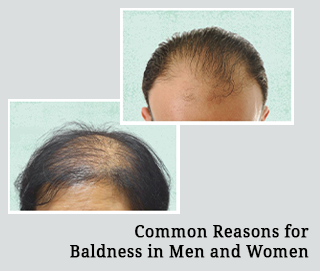Common Reasons of Baldness in Men and Women

Baldness is a condition that affects both men and women, often causing distress, and they search for baldness solutions everywhere. Hair loss is a natural part of aging, and understanding the specific reasons for baldness can help individuals make informed decisions about prevention and treatment.
In this comprehensive guide, we will explore the ten common reasons for baldness, shedding light on the intricacies of genetic factors, hormonal imbalances, stress, nutritional deficiencies, medical conditions, scalp conditions, environmental factors, hair styling practices, and the inevitable impact of ageing.
1. Genetic Factors:
Genetic factors are considered the leading cause of baldness. Baldness, particularly male-pattern baldness, is significantly influenced by genetic factors. Research indicates that individuals with a family history of baldness are likelier to experience hair loss.
According to a study published in the “Journal of Investigative Dermatology,” the inheritance pattern for androgenetic alopecia, the scientific term for male-pattern baldness, is polygenic. This means multiple genes contribute to the susceptibility to baldness, making it a complex trait with a hereditary component.
Statistics from the American Academy of Dermatology reveal that approximately 80 million people in the United States experience hereditary hair loss. Moreover, the likelihood of developing baldness increases if both parents have a history of hair loss. The study, “Genetic epidemiology of androgenetic alopecia: a 30-year follow-up study in middle-aged Swedish twins,” published in the “Journal of the American Academy of Dermatology,” emphasises the strong genetic influence on baldness, particularly in male individuals.
Understanding the genetic basis of baldness and the causes of baldness in men not only sheds light on its hereditary nature but also underscores the importance of early intervention and preventive measures for those at higher genetic risk. Genetic testing and counselling can give individuals valuable insights into their predisposition to baldness, allowing for proactive management strategies.
2. Hormonal Imbalances:
Hormonal imbalances, specifically involving androgens, play a pivotal role in the onset of baldness in both men and women. In men, the hormone dihydrotestosterone (DHT) is a significant contributor to androgenetic alopecia, the most common form of male pattern baldness. A study in the “Journal of Clinical Endocrinology & Metabolism” highlights the correlation between elevated levels of DHT and the miniaturisation of hair follicles, ultimately leading to hair loss. The prevalence of androgenetic alopecia increases with age, coinciding with hormonal shifts in men.
In women, hormonal fluctuations during various life stages, such as pregnancy and menopause, contribute to female pattern baldness. The “American Journal of Clinical Dermatology” reports that hormonal changes, particularly variations in estrogen and progesterone levels, some common female baldness reasons, can trigger hair loss in women. Postmenopausal women, experiencing a decline in estrogen, are particularly susceptible to hair thinning and loss.
Statistics from the American Academy of Dermatology underscore the impact of hormonal imbalances, revealing that up to 40% of women experience noticeable hair loss by age 40. Understanding the intricate interaction of hormones in both genders is crucial for developing targeted interventions and therapies to address hormonal imbalances, and causes of baldness and mitigate the effects of baldness.
3. Stress and its Impact:
Chronic stress can have profound effects on the body, and hair loss is one of its potential consequences. Stress-induced hair loss, known as telogen effluvium, occurs when hair follicles are prematurely pushed into the resting phase. Understanding the connection between stress and baldness emphasises the importance of stress management for overall well-being.
4. Nutritional Deficiencies:
The connection between nutritional deficiencies and baldness underscores the importance of maintaining a well-balanced diet for optimal hair growth. Research published in the “Journal of Cosmetic Dermatology” reveals that deficiencies in essential nutrients, such as vitamins, minerals, and proteins, can lead to weakened hair follicles and contribute to various forms of hair loss.
Iron deficiency, for example, has been associated with telogen effluvium, a condition where more hair follicles than usual enter the resting phase, resulting in increased shedding. According to the World Health Organization, iron deficiency affects approximately 30% of the global population, emphasising its potential impact on hair health.
Furthermore, inadequate vitamin D, zinc, and omega-3 fatty acids have been linked to hair loss. A study in the “Dermatology and Therapy” journal suggests that maintaining sufficient levels of these nutrients is crucial for promoting hair growth and preventing hair thinning.
National Institutes of Health statistics indicate that nutritional deficiencies contribute significantly to hair loss, especially among individuals with restrictive diets or certain medical conditions. Recognizing the role of nutrition in hair health is paramount for individuals seeking to address or prevent baldness through dietary interventions and supplements.
5. Medical Conditions:
Medical Conditions and Baldness: Unravelling the Intricate Links
Alopecia Areata:
- Alopecia areata is an autoimmune condition where the immune system mistakenly attacks hair follicles, leading to hair loss.
- According to the National Alopecia Areata Foundation, approximately 6.8 million people in the United States are affected by this condition.
Lupus:
- Systemic lupus erythematosus (SLE) is an autoimmune disease that can cause hair loss due to inflammation.
- A study in the “Journal of the American Academy of Dermatology” reports that hair loss occurs in about 29% of individuals with lupus.
Thyroid Disorders:
- Conditions like hypothyroidism and hyperthyroidism can disrupt the normal hair growth cycle.
- The American Thyroid Association estimates that thyroid disorders affect about 20 million Americans, and thyroid-related hair loss is common.
Chemotherapy-Induced Hair Loss:
- Cancer treatments, particularly chemotherapy, often lead to temporary hair loss.
- The American Cancer Society notes that the extent and duration of chemotherapy-induced hair loss vary depending on the drugs used.
Trichotillomania:
- Trichotillomania is a psychological disorder where individuals compulsively pull out their hair.
- The “Journal of the American Academy of Dermatology” reports that trichotillomania affects about 1-2% of the population and can result in significant hair loss.
Understanding the relationship between medical conditions and baldness is crucial for accurate diagnosis and targeted treatment. Seeking medical advice for underlying health issues is essential for managing and mitigating the impact of these conditions on hair health.
6. Scalp Conditions:
Scalp Conditions and Baldness: Navigating the Root Causes
Seborrheic Dermatitis:
- Seborrheic dermatitis is a common scalp condition characterised by red, itchy, and flaky skin.
- A study in the “International Journal of Dermatology” highlights that seborrheic dermatitis can contribute to hair loss, affecting up to 42% of the population.
Psoriasis:
- Psoriasis, an autoimmune condition causing raised, scaly patches on the skin, can also affect the scalp.
- According to the National Psoriasis Foundation, about 50% of individuals with psoriasis experience scalp involvement, potentially leading to hair loss.
Fungal Infections:
- Fungal infections like ringworm can impact the scalp and hair follicles.
- The “Journal of Investigative Dermatology” reports that fungal infections can cause hair loss, especially in children, and are a significant global health concern.
Scarring Alopecia:
- Scarring alopecia results from inflammation that damages hair follicles and replaces them with scar tissue.
- The American Academy of Dermatology notes that scarring alopecia can lead to permanent hair loss and is often associated with various underlying conditions.
Traction Alopecia:
- Traction alopecia is caused by persistent tension on hair, often due to tight hairstyles.
- The “Journal of the American Academy of Dermatology” reports an increasing incidence of traction alopecia, especially among individuals with certain hairstyling practices.
Understanding the impact of scalp conditions on baldness is crucial for effective management and prevention. Seeking professional guidance for diagnosing and treating scalp conditions ensures a targeted approach to preserving and promoting healthy hair growth.
7. Environmental Factors:
Environmental factors, including exposure to pollutants, harsh chemicals, and UV radiation, can contribute to hair loss. Recognizing the impact of the environment on hair health highlights the need for protective measures and lifestyle adjustments to mitigate potential damage.
8. Hairstyling Practices:
Certain hairstyling practices, such as tight hairstyles, excessive heat styling, and chemical treatments, can damage hair and lead to breakage and loss. Understanding the impact of hairstyling practices on hair health empowers individuals to make informed choices about their grooming routines.
9. Ageing:
Ageing is an inevitable factor contributing to hair loss. As individuals age, hair follicles shrink, and hair growth slows down. Understanding how ageing affects hair health is essential for setting realistic expectations and implementing preventive measures.
Why choose a hair transplant treatment at the DHI clinic?
DHI technique and its benefits are propriety to DHI International Medical Group. Some clinics and doctors try to copy this and claim to use the DHI technique, which is misleading. The following features are only available at DHI-authorised clinics.
1) We are proud to be ranked #1 on customer satisfaction in a hair transplant industry survey by IMRB. Our customer satisfaction rate is more than 99%. Also, they received the Customer Excellence Award from Quantic and numerous other awards & accreditations from medical bodies worldwide.
2) Our results are not just good; they are fantastic! Click LINK to see our results and LINK for our customer feedback.
3) We provide hair restoration services for all stages of hair loss for men and women. This includes high growth factor PRP/GFC therapies and Activa Regenera treatment for early-stage alopecia, hair transplant for all stages of alopecia, and the highest quality natural human hair cosmetic patches for very advanced stages of alopecia. Our hair loss treatment products and nutraceuticals have the highest-grade active ingredients, and you can shop for them here.
4) All procedures are performed from start to finish by DHI doctors trained and certified by the London Hair Restoration Academy. All the surgeons are focused on hair restoration procedures only. Every procedure goes through strict quality control.
5) All procedures are performed per strict standard operating protocols accredited with the UK Care Quality Commission and ISO standards.
6) The world’s safest hair transplant procedure performed in a sterile environment as per comprehensive safety protocols. All procedures are performed only after proper diagnosis and medical tests.
7) Perfect control over angle, depth, and direction with our patented implanter. Only the highest quality imported instruments are used and discarded after every procedure.
8) One-step implantation to ensure minimal graft handling. Highest graft survival rate of over 90% as compared to 50-90% in other clinics.
9) There are no stitches, no pain, no scarring, and no downtime. You can return to work the next day. It is just a short procedure to regrow your hair naturally and permanently. Daily Mail UK titled DHI the “Lunch Hour Transplant” (click here to read the article).
10) Achieve strong density in a session compared to other low-density techniques such as FUE and FUT.
11) Natural Results Guaranteed – The DHI technique gives you a perfectly natural result; others will only know you had a transplant if you tell them.
12) DHI is the world’s largest hair restoration medical group from Greece. For more than 50 years, we have focused on research, innovation, and education in hair restoration. We have 75 clinics in 45 countries serving more than 5,00,000 satisfied customers. Top celebrities from the entertainment, sports, business, and politics only trust DHI for their hair restoration!
Conclusion:
In conclusion, the causes of baldness are diverse and multifaceted, encompassing genetic, hormonal, environmental, and lifestyle factors. Recognizing the interplay of these elements is crucial for effective prevention and treatment strategies. Whether considering hair transplant options for baldness or addressing nutritional deficiencies, a comprehensive approach tailored to the specific causes of baldness is key to promoting healthy hair growth.
Remember, seeking professional advice from dermatologists or trichologists is essential for accurate diagnosis and personalised treatment plans. With a thorough understanding of the common causes of baldness, individuals can navigate their hair loss journey with knowledge and confidence.
